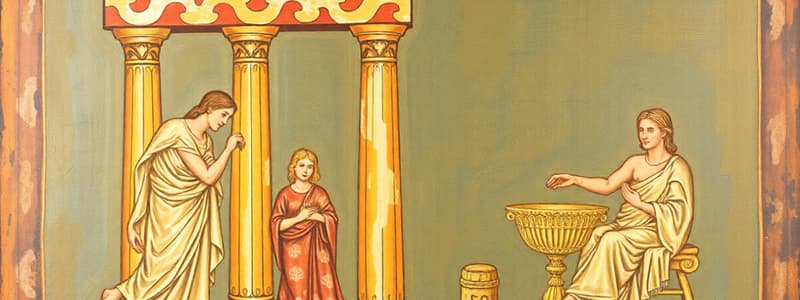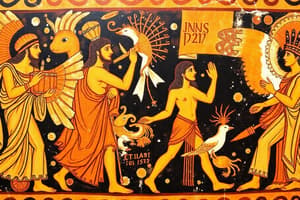Podcast
Questions and Answers
¿Cuál de los siguientes ejemplos representa una obra de la arquitectura griega?
¿Cuál de los siguientes ejemplos representa una obra de la arquitectura griega?
- El Doryphoros
- La Venus de Milo
- El Discóbolo
- El Parthenon/Acropolis (correct)
¿Qué característica del período Arcaico en la escultura griega es más evidente?
¿Qué característica del período Arcaico en la escultura griega es más evidente?
- Poses rígidas y sonrisas arcaicas (correct)
- Naturalismo y emoción
- Representaciones detalladas de la figura humana
- Dramas narrativos intensos
Durante qué periodo de la escultura griega se observan avances hacia un mayor naturalismo y balance?
Durante qué periodo de la escultura griega se observan avances hacia un mayor naturalismo y balance?
- Período Helenístico
- Período Clásico (correct)
- Período Arcaico
- Período Romano
¿Qué materiales fueron fundamentales en la escultura griega para la durabilidad y el estilo?
¿Qué materiales fueron fundamentales en la escultura griega para la durabilidad y el estilo?
¿Qué escultura es un ejemplo icónico del período Helenístico por su intensidad emocional?
¿Qué escultura es un ejemplo icónico del período Helenístico por su intensidad emocional?
¿Cuál de las siguientes características define el estilo geométrico en la pintura griega?
¿Cuál de las siguientes características define el estilo geométrico en la pintura griega?
¿Cuál es una característica distintiva del estilo arcaico en la pintura griega?
¿Cuál es una característica distintiva del estilo arcaico en la pintura griega?
La pintura del período clásico se caracteriza por:
La pintura del período clásico se caracteriza por:
En qué se distingue el estilo helenístico de la pintura griega:
En qué se distingue el estilo helenístico de la pintura griega:
¿Cuál de los siguientes elementos es característico del orden dórico en la arquitectura griega?
¿Cuál de los siguientes elementos es característico del orden dórico en la arquitectura griega?
El orden jónico en la arquitectura se distingue por:
El orden jónico en la arquitectura se distingue por:
¿Cuál es la característica más notable del orden corintio en la arquitectura griega?
¿Cuál es la característica más notable del orden corintio en la arquitectura griega?
¿Cuál de las siguientes afirmaciones sobre la evolución de la pintura griega es correcta?
¿Cuál de las siguientes afirmaciones sobre la evolución de la pintura griega es correcta?
Flashcards
¿Qué caracteriza a la escultura griega arcaica?
¿Qué caracteriza a la escultura griega arcaica?
La escultura griega arcaica se caracteriza por posturas rígidas, sonrisas arcaicas y un realismo limitado.
¿Qué cambio en el periodo clásico de la escultura griega?
¿Qué cambio en el periodo clásico de la escultura griega?
El periodo clásico avanzó hacia un mayor naturalismo, equilibrio y emoción en las esculturas, como el Doryphoros y la Venus de Milo.
¿Qué enfatizó el periodo helenístico en escultura?
¿Qué enfatizó el periodo helenístico en escultura?
El periodo helenístico se caracterizó por un mayor énfasis en la intensidad emocional, las narrativas dramáticas y las representaciones detalladas.
Influencia de los materiales en la escultura griega
Influencia de los materiales en la escultura griega
Signup and view all the flashcards
Temas de las esculturas griegas
Temas de las esculturas griegas
Signup and view all the flashcards
Estilo geométrico griego
Estilo geométrico griego
Signup and view all the flashcards
Estilo arcaico griego
Estilo arcaico griego
Signup and view all the flashcards
Estilo clásico griego
Estilo clásico griego
Signup and view all the flashcards
Estilo helenístico griego
Estilo helenístico griego
Signup and view all the flashcards
Órdenes arquitectónicas griegas
Órdenes arquitectónicas griegas
Signup and view all the flashcards
Orden dórico
Orden dórico
Signup and view all the flashcards
Orden jónico
Orden jónico
Signup and view all the flashcards
Orden corintio
Orden corintio
Signup and view all the flashcards
Study Notes
Greek Art: Painting, Styles, and Periods
- Greek painting, despite limited surviving examples, is understood through depictions in vases and descriptions by ancient authors.
- Early Greek painting, largely lost, likely involved geometric patterns and figures, akin to the pottery of the Geometric period.
- The development of figurative representation was significant, evolving through various styles like the archaic period.
- Archaic Greek painting frequently depicted mythological scenes, often employing black-figure or red-figure techniques on pottery. This helped to establish a foundation for later styles.
- Classical-era painting moved toward greater realism and naturalism, though surviving examples remain scarce, mostly on vases or fragments.
- Hellenistic painting saw a diversification of styles, introducing greater realism, emotion, and perspective in subject matter.
- Painted murals, less frequent than sculpture or pottery, also demonstrate the development and style in Greek fine art.
Greek Painting Styles
- Geometric style: Primarily on pottery, characterized by geometric patterns, stylized human figures, and narrative elements.
- Archaic style: Figures become more human-like, though with rigid poses; mythological and religious themes dominate.
- Classical style: Increased naturalism and realism in figure representation; scenes of everyday life and mythology.
- Hellenistic style: Depicting emotion, drama, and a wider range of subjects, including everyday life and scenes of high drama.
- Technique differences: Different styles employed various techniques, such as black-figure and red-figure on pottery, impacting aesthetics and details presented.
Greek Architectural Styles and Periods
- Early Greek architecture, marked by the use of timber and post-and-lintel construction, evolved into more complex and monumental forms.
- The three main architectural orders, Doric, Ionic, and Corinthian, emerged and became distinctive elements of Greek culture, varying in columns, details, and characteristics.
- Doric Order: Simplistic form, characterized by vertical triglyphs and metopes on the entablature.
- Ionic Order: More elaborate than Doric, featuring volutes on the capital of the column.
- Corinthian Order: Most elaborate, distinguished by acanthus leaves on the capital.
- Primarily temples, theaters, and public buildings exemplified the various orders and their sophistication.
- Examples include the Parthenon/Acropolis, the Temple of Artemis at Ephesus, and the Athenian Agora.
- Development of Greek architecture spanned archaic, classical, and Hellenistic periods.
Greek Sculpture: Styles and Periods
- Early Greek sculpture, particularly in the Archaic period, showcased stiff poses, archaic smiles, and limited realism.
- The Classical period saw advancements towards greater naturalism, balance, and emotion, exemplified by sculptures like the Doryphoros and the Venus de Milo.
- The Hellenistic period introduced a greater emphasis on emotional intensity, dramatic narratives, and detailed representations in its various sculpture styles.
- Examples of sculptures include the bronze 'Discus Thrower,' the 'Kritios Boy,' and the 'Nike of Samothrace'.
- Material variations such as bronze and marble played a critical role in the style and durability of the sculptures throughout the periods.
- Greek sculpture, spanning generations, evolved in styles from Archaic to classical and Hellenistic, becoming increasingly accurate, dynamic, and emotional.
- Subjects encompassed gods, heroes, and athletes, reflecting the beliefs and values of the Greek world.
- The techniques involved in carving marble and bronze, and the use of specific tools varied depending on the desired style.
Studying That Suits You
Use AI to generate personalized quizzes and flashcards to suit your learning preferences.




